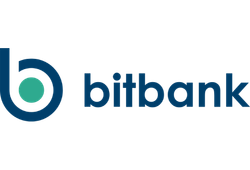
Free Airdrop Season 7 is LIVE! Answer fun questions or do simple tasks to earn rewards from the $30K BitDegree prize pool. Participate Now ! 🔥
While Japan isn’t always in the crypto spotlight like the US, China, Russia, or El Salvador, it’s steadily growing its exchange scene. The number of platforms operating in the country is climbing, and in this Bitbank review, I’ll be taking a closer look at one of them.
Founded in 2014 as Bitcheck by Noriyuki Hirosue, Bitbank has grown into one of Japan’s largest crypto exchanges, even claiming the top spot in domestic altcoin trading volume. It primarily serves the local market, offering a solid range of services, including spot trading, margin trading, and crypto lending.
But Bitbank isn’t just staying local. It’s opening its doors to corporate entities outside Japan, pushing for a more global presence and aiming to make value distribution seamless worldwide. The big question is—how does it stack up against the likes of Bybit, bitFlyer, and Uphold? Let’s find out.
Verdict at a Glance:
Bitbank is a well-regulated exchange built for the Japanese crypto market. It’s got spot trading, margin trading, and lending, all packed into a user-friendly platform with competitive fees. But, access is pretty limited since it’s only available to Japanese residents and international corporations.
Pros
- Simple and clean platform
- Affordable trading costs
- Universal JPY pairs
- Regulation-compliant
Cons
- Lacks multi-language support
- No multi-fiat options
- Exclusive to residents of Japan and foreign corporations
Table of Contents
- 1. Bitbank Review: Quick Overview
- 2. Bitbank Alternatives
- 3. Who’s Bitbank For?
- 4. Advantages
- 5. Limitations
- 6. Fees and Limits
- 7. Lending Rewards
- 8. Security
- 9. Customer Support
- 10. Trading Tools
- 11. User Experience
- 12. Localization and Regional Adaptability
- 13. How to Use Bitbank
- 13.1. How to Create a Bitbank Account
- 13.2. How to Deposit on Bitbank
- 13.3. How to Withdraw From Bitbank
- 14. Comparison to Other Popular Exchanges
- 14.1. Bitbank VS Bybit
- 14.2. Bitbank VS bitFlyer
- 14.3. Bitbank VS Uphold
- 15. Conclusions: Is Bitbank Right for You?
Bitbank Review: Quick Overview
Before getting into the details of this Bitbank review, here’s a quick snapshot of the platform’s key characteristics and features:
Type | CEX |
Is Bitbank Safe? | Yes |
Best for | Intermediate to advanced traders |
Established in | 2014 |
Headquarters | Tokyo, Japan |
Availability | Limited availability outside Japan |
Licenses | Financial Services Agency |
KYC Verification | Yes |
Security | 2FA, multi-sig wallet |
Features | Spot trading, margin trading, lending |
Supported Coins | BTC, ETH, XRP, and 40 more |
Funding Methods | Bank transfer |
Maker/Taker Fees | -0.02% maker / 0.12% taker |
Fiat Support | Yes (JPY only) |
Customer Support | Email, ticket, chatbox, social media |
Privacy & Anonymity | No anonymity features |
Table: Quick overview of Bitbank
Does the quick overview table grab your interest, or are you still on the fence about Bitbank? If you’re curious to see what it truly offers, we'll dive into in in a sec, and break down its features in detail!
Bitbank Alternatives
But before we go any further, if at any point in my Bitbank review, you start feeling like this platform isn’t quite the right fit, that’s totally fair—there’s no shortage of exchanges out there. But don’t get lost in the endless choices. I’d say these three alternatives should be your first stop before looking anywhere else:
- Bybit. One of the top-tier exchanges on the market, offering 1,500+ cryptocurrencies, advanced trading tools, and earning options. With competitive fees and a feature-rich platform, it’s a go-to for both spot and derivatives traders.
- BitFlyer. If you’re looking for another Japan-focused exchange, this one’s also worth checking out. It delivers a secure trading environment, an intuitive interface, and competitive fees, making it a strong choice for traders in the Japanese market.
- Uphold. In this multi-asset platform, you can trade, hold, and spend over 300 cryptocurrencies, alongside fiat and precious metals. It also comes with a crypto debit card, staking options, and seamless fiat on/off ramps across multiple regions.

|

|

|
|
|---|---|---|---|
| Wide Range of Assets | More Advanced Users | Beginners | |
| United States, Argentina, United Kingdom, Mexico, France, +180 more | South Korea, United Kingdom, Ukraine, Turkey, +160 more | Japan, United States, Taiwan, United Kingdom, France, + 30 more | |
| All Uphold Coupons | See All Coupons of Best Exchanges | See All Coupons of Best Exchanges | |
| A reliable multi-asset exchange for trading crypto, fiat, and precious metals. | A popular crypto derivatives exchange with some super-low trading fees. | One of the more-interesting and better underdogs of the cryptocurrency exchange market. | |
|
Visit site
Read review |
See TOP10 Brands
Read review |
See TOP10 Brands
Read review |
Table: Comparison of Bybit, bitFlyer, and Uphold
Now, you might also be wondering—is Bitbank as safe or reliable as these alternatives? I hear you. Stick around because I’ll break it all down later, giving you a full comparison so you can make the best call!

Did you know?
All Crypto Exchanges may look similar to you but they're NOT all the same!
Who’s Bitbank For?
As mentioned earlier, there are numerous exchanges out there, each catering to different needs. Bitbank, however, is designed with a specific type of user in mind. Let’s see if you fit the bill:
- Crypto traders in Japan. The platform is a Japan-based exchange that primarily serves local traders. If you're trading in the country and need a regulated, secure, and easy-to-use platform, Bitbank Japan is a solid option to consider.
- Corporate users. Businesses, hedge funds, and proprietary trading firms outside Japan looking for a reliable platform to execute large-volume trades can also use Bitbank. The exchange supports institutional accounts and provides liquidity for crypto assets, making it a potential fit for enterprise-level trading.
- Financial service providers. Bitbank also accommodates registered financial service providers, such as money remittance companies, that need access to crypto trading for operational purposes.
From these points, it's clear that Bitbank Japan is heavily focused on serving its local market, with enterprise users being the only exception. If you’re an everyday trader outside the country, you might want to consider other options.
📚 Read More: Best Cryptocurrency Exchange
Advantages
Alright, let’s kick things off with the positives. These are the features that stood out to me the most while I was exploring the platform:
- User-friendly interface;
- Competitive fees;
- JPY pairing for all coins;
- Well-regulated.
Now, let’s break it down.
First off, I have to say that I really like how the platform is laid out. It’s smooth, clean, and easy to navigate. Even with one glaring issue (which I’ll get to in the next section), everything still feels neatly arranged.
Bitbank's design is minimalist but doesn’t sacrifice efficiency, keeping things intuitive without any of that overcomplicated UI.
Then there’s the fee structure, which is pretty competitive. Taker fees are on the higher side at 0.12%, but with solid liquidity and strong regulatory oversight, it’s not exactly a dealbreaker. The real standout, though, is the negative maker fee of -0.02%, meaning you actually get paid for placing limit orders.
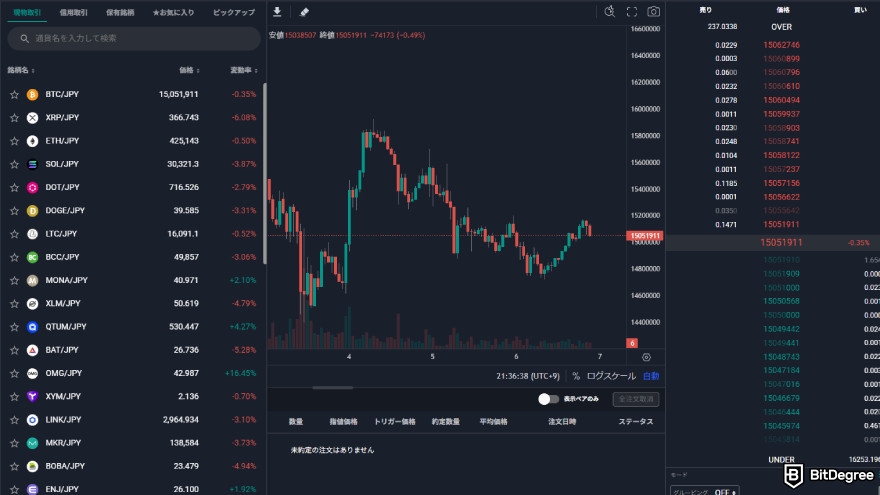
Now, my favorite part is that every single coin on the spot market is paired with JPY. Not just BTC, ETH, and XRP, but all 43 listed cryptos, including some lesser-known altcoins. That’s a big deal for liquidity, making it easier to enter and exit positions without weird conversion gymnastics.
And last but not least—regulation. Bitbank is legit, fully registered with Japan’s Financial Services Agency (FSA), and one of the few exchanges that lets corporate entities from outside the country open accounts. That said, they don’t mess around with KYC, as even institutional players have to go through a strict verification process, adding an extra layer of security and trust.
📚 Related: How to Buy Crypto Without KYC
Limitations
Like everything under the sun, nothing’s perfect—including Bitbank. Here’s where I think it comes up short:
- Japanese-only interface;
- Limited fiat support.
The biggest hurdle I found is the complete lack of an English interface. Now, imagine me navigating the platform, testing every feature for the sake of writing this Bitbank review—all powered by intuition, Google Translate, and my inept weeb knowledge. Let’s just say it was rough.
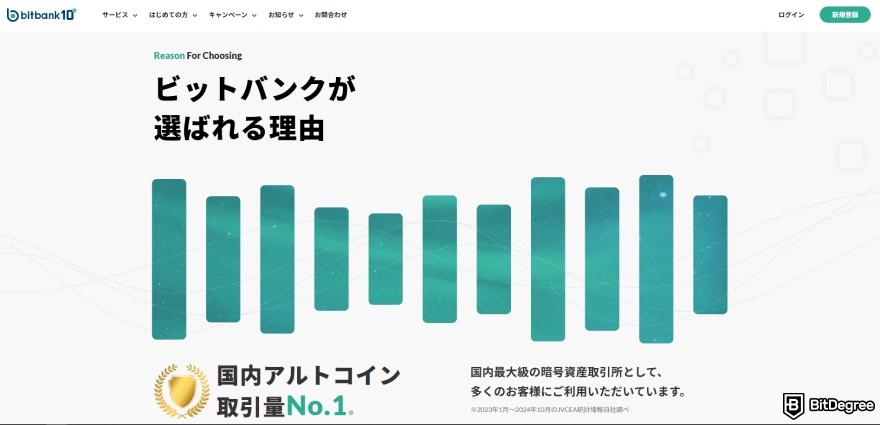
I get that it's primarily designed for Japanese crypto traders, but here’s the thing: it openly invites corporate users from outside Japan. Yet, without English or any other language support, international users are left fumbling with a translator or relying on customer support just to perform basic functions. That’s far from practical, especially for a platform aiming to attract global businesses.
And that brings me to the second major limitation: yen is the only fiat option. If you’re trading in Japan, that might not seem like a big deal. However, for overseas enterprises—or even local traders who’d prefer USD or EUR—this restriction can be quite vexing.
Fees and Limits
Here’s a breakdown of Bitbank's fees, covering deposits, withdrawals, trading, and account costs, so you know exactly what you’re dealing with.
Type | Fees | Limits |
|---|---|---|
Deposit | Free! | No limit |
Withdrawal | JPY: ¥550 (below ¥30,000), ¥770 (above ¥30,000) Crypto: Depends on coin and network | JPY: ¥100 million daily Crypto: Depends on coin and network |
Trade | -0.02% maker; 0.12% taker | - |
Registration | Free! | - |
Account Management | Free! | - |
Table: Bitbank fees and limits
- JPY Withdrawal Fees. Withdrawing JPY costs ¥550 for amounts under ¥30,000 and ¥770 for anything higher, tax included. However, if the bank details are incorrect and the withdrawal is rejected, the funds will be returned to the trading account, but the withdrawal fees will not be refunded.
- Crypto Withdrawal Fees. Fees for withdrawing crypto depend on the coin and network. For example, Bitbank BTC withdrawals cost 0.0006 BTC, while LTC withdrawals incur a 0.0015 LTC fee.
- Trading Fees. Bitbank keeps its trading fees competitive with maker fees at -0.02%, giving traders a small rebate for adding liquidity, while taker fees sit at 0.12%, which is on the higher side compared to other platforms.
- Deposit Fees. Completely free, whether you're transferring JPY via a bank or depositing crypto.
- Account Registration & Maintenance. Signing up and keeping your account running won’t cost you a thing. There are no hidden charges or monthly fees to worry about.
All in all, Bitbank keeps its fees pretty competitive for the Japanese market, especially with those negative maker fees giving traders a little extra edge.
Lending Rewards
In principle, lending works similarly to depositing money in a bank—you loan out your holdings, lock them up for an agreed period, and can’t access them until the term ends. However, unlike traditional banks, it often offers significantly higher interest rates,[1] making it an appealing option for crypto holders looking to earn passive income.
That brings up the question: what is Bitbank’s lending interest rate, and is it actually attractive?
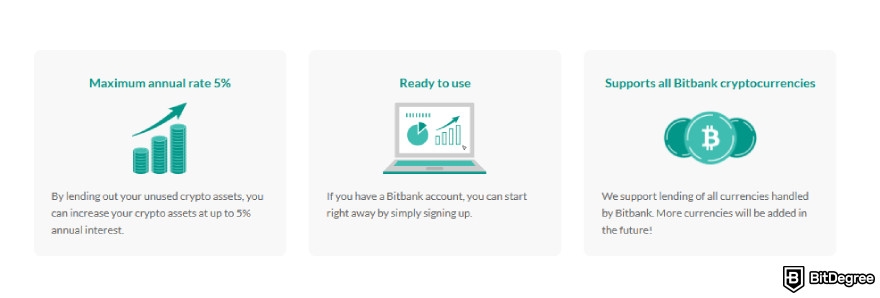
Well, that depends on what you’re expecting—but for me? It's pretty solid. You can earn up to 5% per year, which is a strong return compared to Japan’s rock-bottom interest rates.
Keep in mind, though—once you commit to a lending contract, you’re pretty much locked in. There’s no early withdrawal, and if you cancel, you lose any earned interest and get hit with a 5% early termination fee on the returned crypto.
Security
Bitbank claims to have unique security measures that have kept it hack-free since its founding. That’s a pretty bold claim, and while I can’t verify it firsthand, I’d say the platform has some solid protections in place—though nothing particularly groundbreaking.

For starters, it uses a multi-signature cold wallet system alongside a hot wallet management setup. Crypto assets are secured with physically and virtually distributed key management, which adds an extra layer of protection.
On top of that, Bitbank has also earned ISO/IEC 27001:2013 certification, an internationally recognized information security management system (ISMS) standard.
The certification covers the planning, development, and operation of its exchange, which, in my opinion, is a good sign that it takes security seriously rather than just making big claims.
Then there’s two-step verification (2FA), which primarily relies on authentication apps like Google Authenticator. I always recommend enabling this as soon as you create an account, as it’s a proven way to strengthen your account’s protection against unauthorized access.[2]
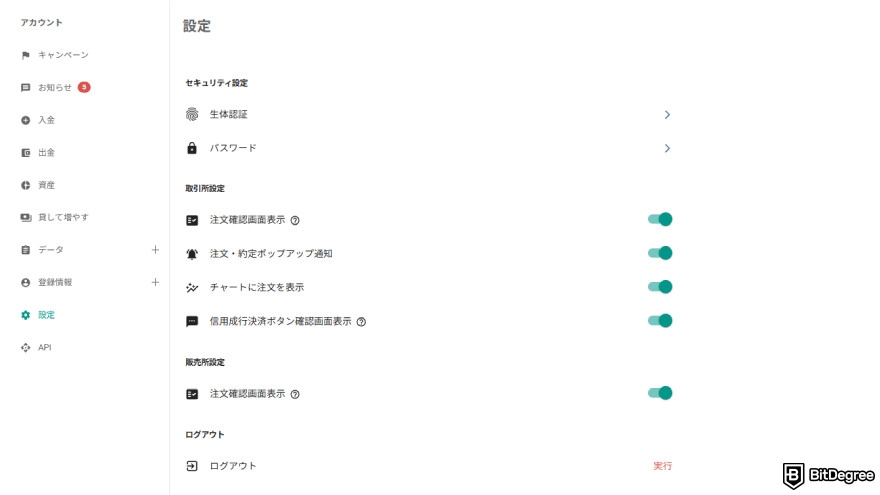
So, is Bitbank safe? Based on its security measures, I’d say yes. The platform has multiple security features in place, demonstrating its commitment to protecting user assets. That said, while it has remained hack-free so far, whether it can uphold that record indefinitely is yet to be seen.
Customer Support
When it comes to Bitbank customer service, it offers several channels for reaching out. The most noticeable one is the chatbox, which you’ll find conveniently placed on every page of the platform. It works seamlessly, starting with an AI-powered bot that tries to address your query before escalating it to a human agent if the issue is too complex.
Another option is the ticket system, accessible through the "Contact Us" page. It’s fairly standard—you’ll need to provide details like your email, name, and the type of issue or question you have. That said, keep in mind that support is only available from 10:00 to 19:00 on weekdays, so don’t expect immediate responses outside those hours.
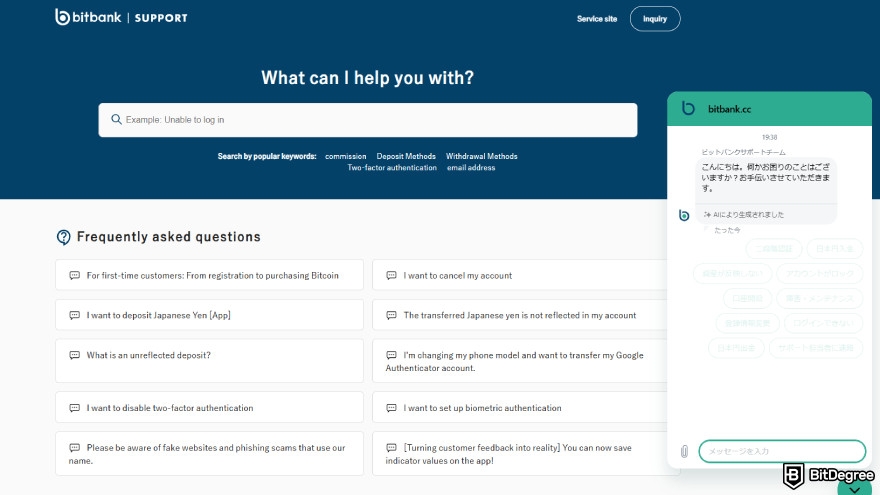
On top of that, Bitbank’s platform features a decent support page with a solid (though not overwhelming) collection of Frequently Asked Questions (FAQs). If you’re looking to solve something on your own, the FAQ section can be pretty reliable before turning to Bitbank customer service help.
Trading Tools
While Bitbank Japan crypto exchange may not offer the most extensive set of tools, it provides all the essentials traders need. Its spot trading service offers access to 43 cryptocurrencies paired with 1 fiat currency (JPY), along with various order types suited to different trading styles:
- Market Orders. Execute trades instantly at the best available price.
- Limit Orders. Set a specific price at which you want to buy or sell.
- Stop Orders. Automate buying or selling when the market hits a certain price.
Now, if you’re someone who likes to take things up a notch, there’s margin trading. This lets you trade with leverage, making the most of the liquidity in the spot market.
But here’s the thing—the leverage isn’t fixed. Bitbank adjusts its limits based on the Japan Cryptocurrency Exchange Association (JVCEA) Cryptocurrency Risk Ratio, which shifts depending on the asset. If you’re into leveraged trading, you’ll want to keep an eye on those changes.
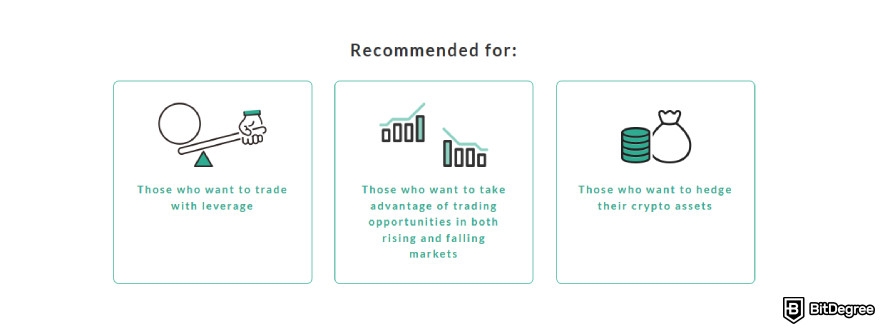
Another feature worth highlighting is Sales Point, a quick buy interface that lets you purchase and sell crypto at the displayed price. It’s clean, intuitive, and ideal for beginners who don’t want to deal with complex order book interfaces. Plus, you can start with as little as 1 yen, making it highly accessible for new users.
For those needing advanced integration, Bitbank offers API access with both REST and real-time stream APIs, providing fast, reliable connectivity and near-zero downtime. This setup ensures smooth execution, making it ideal for corporate and enterprise clients who need efficient trading solutions.
User Experience
Despite the language barrier, navigating Bitbank turned out to be smoother than I expected. This is largely thanks to its intuitive interface, where everything is exactly where you’d expect it to be.
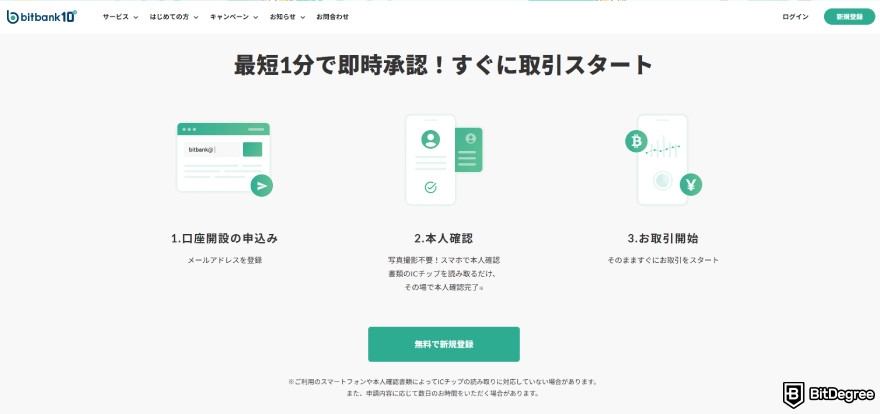
Creating a new account started off as a straightforward process, but the KYC step slowed things down. It felt longer than what I’ve experienced on other platforms. Fortunately, the FAQ section provided clear guidance, which helped me get through it without too much hassle.
Once you’re in, you land on your account dashboard. Some might call the design a bit bland, but I’d argue it’s minimalistic in a good way. It’s clean, simple, and functional. There are no flashy gimmicks or confusing menus—it just works!
The trading interface also deserves mention. It doesn’t attempt to impress with unnecessary features or overly complex layouts but instead focuses on getting the job done efficiently. It feels smooth, responsive, and intuitive—exactly what you need in a trading platform.
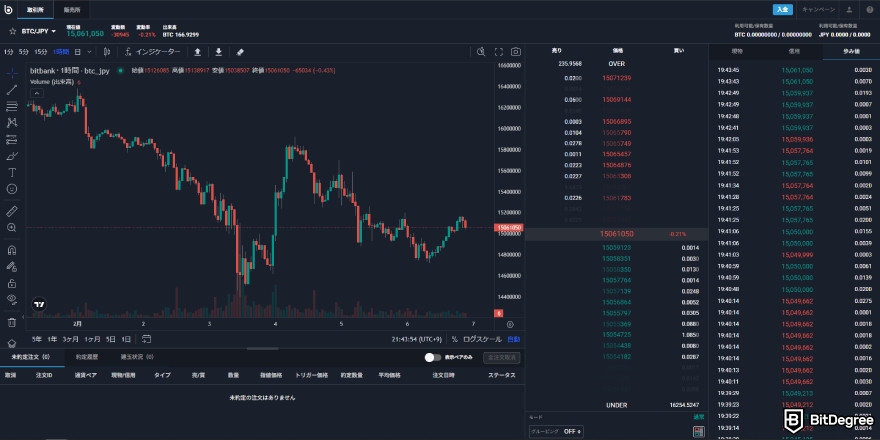
All in all, I had a good time exploring the exchange while putting together this Bitbank review. The lack of any language option besides Japanese did slow me down, but despite that, the platform delivers everything you need from a reliable crypto exchange.
📚 Related Article: How to Choose a Crypto Exchange for Beginners?
Localization and Regional Adaptability
There’s not much to say about Bitbank’s global presence—because, well, it barely has one. This platform is focused on the Japanese crypto market, with little to no interest in expanding beyond its home turf.
As of writing, non-Japanese residents can’t open individual accounts, and if you’re already a customer but decide to move abroad, you’ll have to close it. To be fair, this is likely due to strict adherence to local regulations, but it still reinforces just how Japan-centric Bitbank really is.
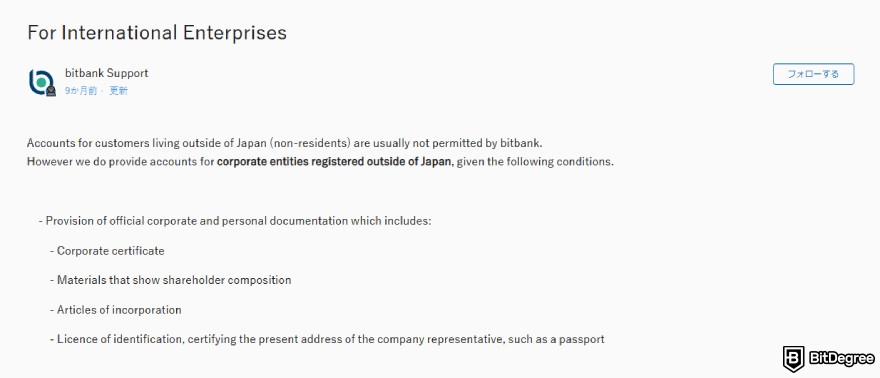
The only exception is that Bitbank allows corporate accounts for entities registered outside of Japan, including:
- Institutional trading firms
- Hedge funds
- Proprietary trading desks
- Other professional money transfer businesses
But here’s the catch—the platform’s interface is entirely in Japanese, which can be a hassle for international corporate clients. Even completing the KYC process might require a translator or direct assistance from Bitbank customer service just to get through it.
How to Use Bitbank
By this point in my Bitbank review, you should have a pretty good idea of whether this platform is worth checking out. If you’re ready to try, the next step is getting hands-on with the platform. And don’t worry—I’ll personally walk you through the entire process, from creating a new account to depositing funds and withdrawing money.
For this guide, I’ll be using the web browser version of Bitbank. If you’re on mobile, you can follow along just the same—the process is nearly identical whether you’re using the Google Play or iOS App Store version.
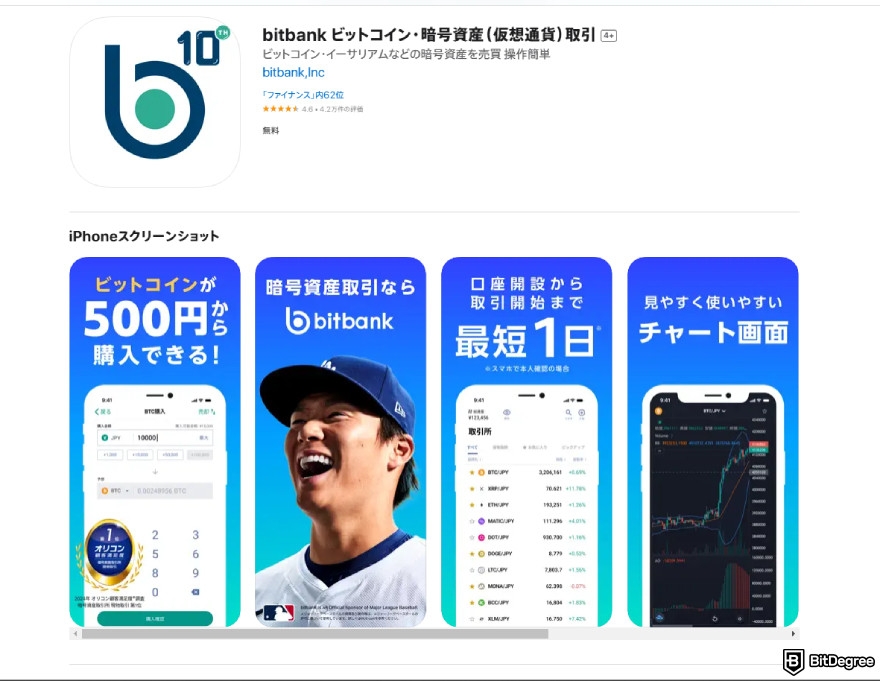
One thing to keep in mind—some of the screenshots will be in Japanese, but don’t worry, you can still follow along even if you’re not fluent. If needed, Google Translate’s webpage translation feature can help make navigation smoother.
How to Create a Bitbank Account
If you're a crypto user in Japan and want to open a new account, the process can take a few steps, but I'll guide you through it. Follow along, and you’ll have everything set up:
Step 1: Go to Bitbank. Visit the Bitbank’s website, then click [Sign Up] at the top left. Alternatively, you can enter your email in the provided field and click [Free Registration] to begin the process.

Step 2: Check Your Email. After clicking [Sign Up], Bitbank will send an authentication email to your registered email address. When you receive it, open the email and click the provided verification link.
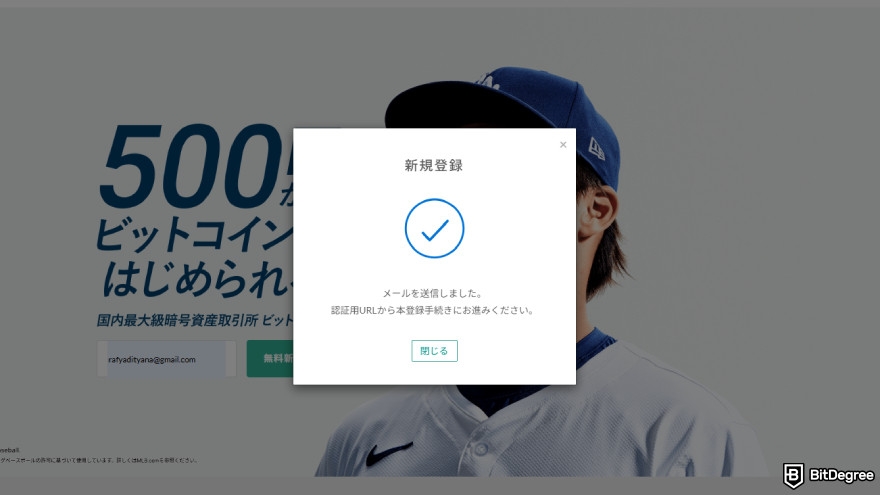
Step 3: Set Up Login Method. Once you click the link, you’ll be prompted to set up a biometric login. If you’d rather use a password, tap [パスワード認証で新規登録] (Register with password authentication) instead.
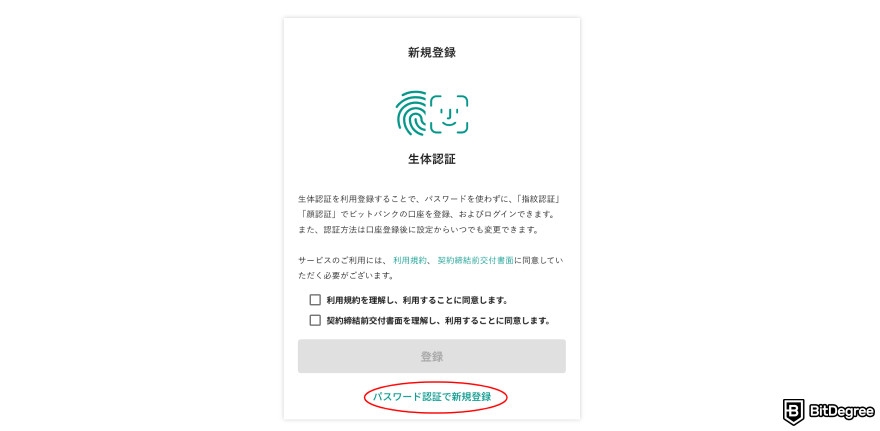
Step 4: Create a Password. If you choose to register with a password, enter your desired password, check the confirmation box, and press [登録] (Register).
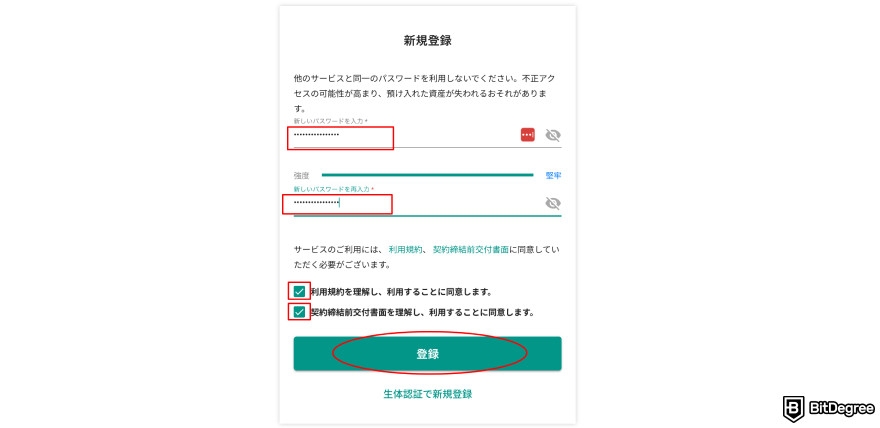
Step 5: Fill in Personal Information. Select [個人口座] (Personal Account) and enter your name, furigana (phonetic reading of your name), and date of birth. Ensure the name matches your bank account details, as this is required for JPY withdrawals.
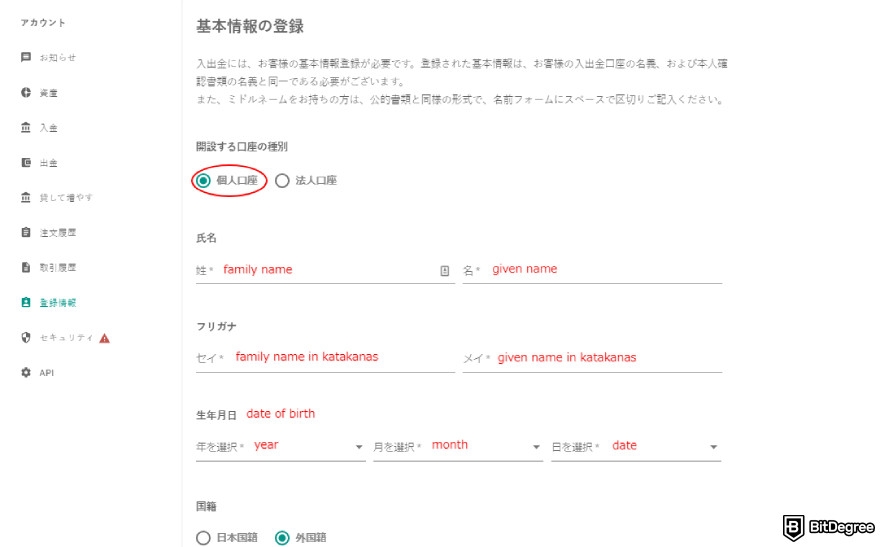
Step 6: Nationality and Address. Select [外国籍] (Foreign Nationality), enter your residential address, and click [次に進む] (Next).
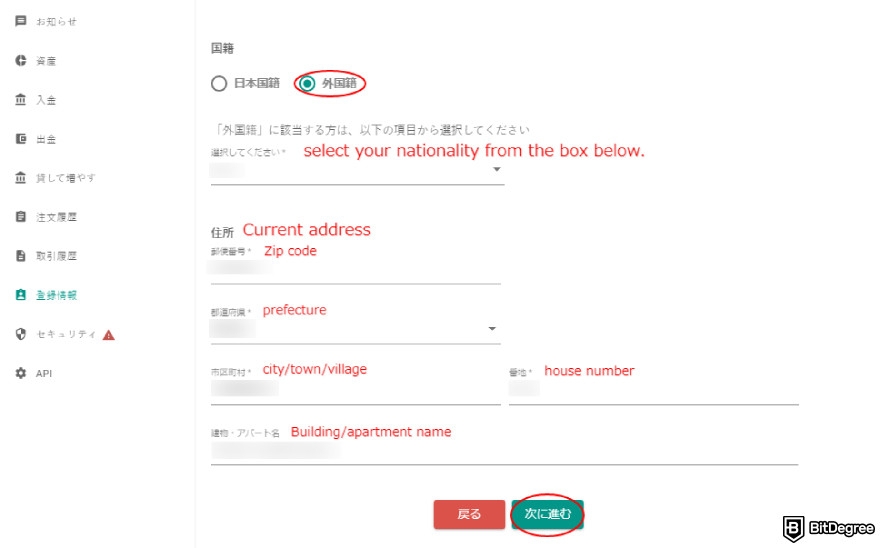
Step 7: Answer the Questions. Go through the questionnaire and select the answers that best describe your situation.
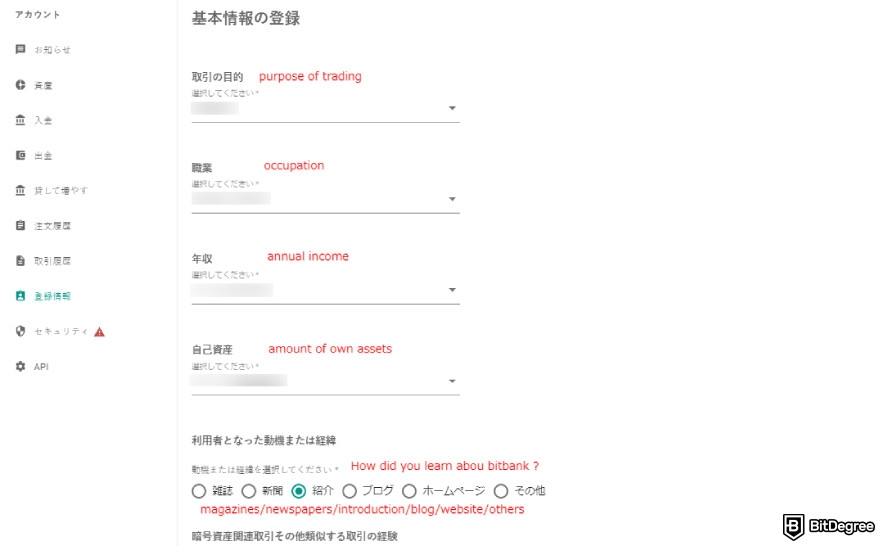
Step 8: Verify Your Identity and Phone Number. Enter your phone number, then confirm that you are not a Politically Exposed Person (PEP) or associated with any anti-social forces. If everything checks out, click [確認] (Confirm).
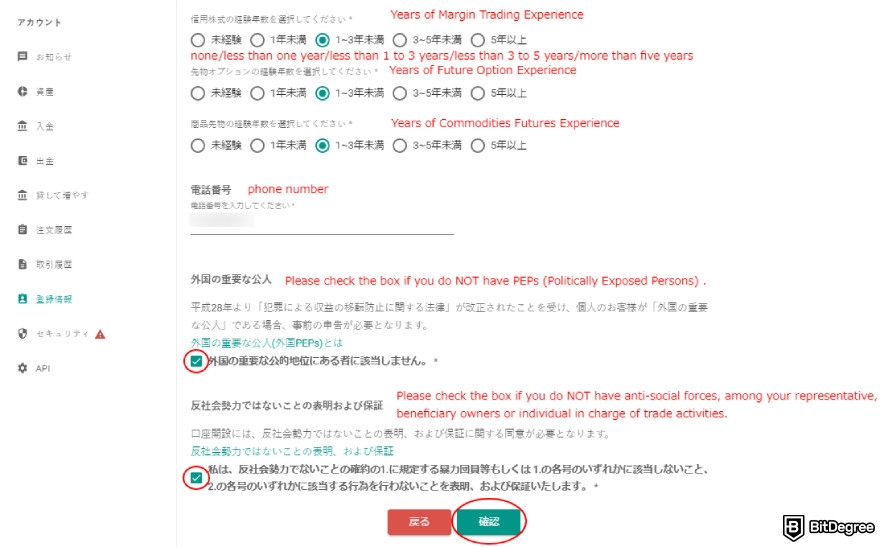
Step 9: Review Your Information. Before proceeding, double-check all the details you’ve entered. If everything is correct, click [登録] (Register) to finalize the process.
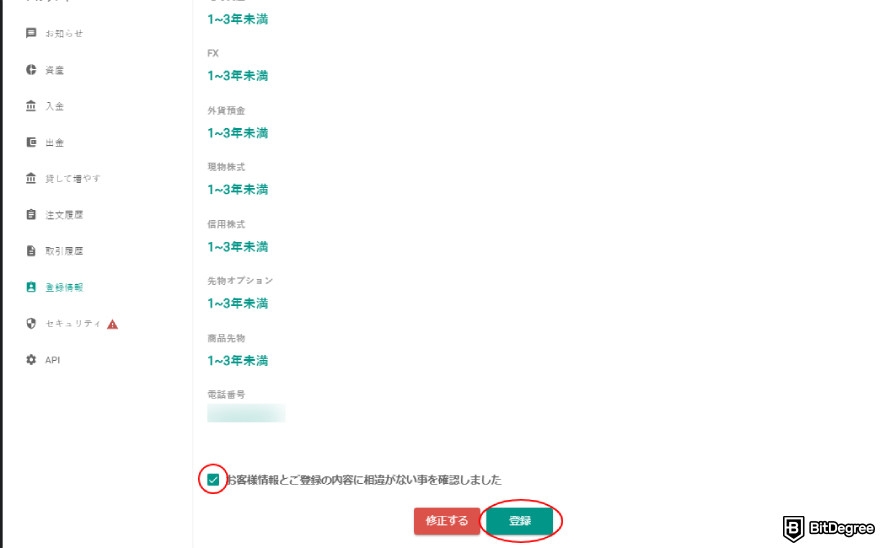
Congratulations! You’ve successfully created your Bitbank account.
To access all features, the next step is identity verification. This involves uploading your identification documents, followed by an address confirmation sent via mail. Keep in mind that the review process may take some time due to high demand.
In the meantime, I strongly recommend enabling 2FA right away. It adds an extra layer of security and helps safeguard your account from unauthorized access.
How to Deposit on Bitbank
Now that your Bitbank account is set up and ready to go, it’s time to fund it so you can start trading. One of the first things you’ll want to do is make a deposit, and in this example, I’ll walk you through the process using Bitcoin as a deposit method:
Step 1: Go to the Deposit Page. Click [入金] (Deposit) from the main menu to begin the process.
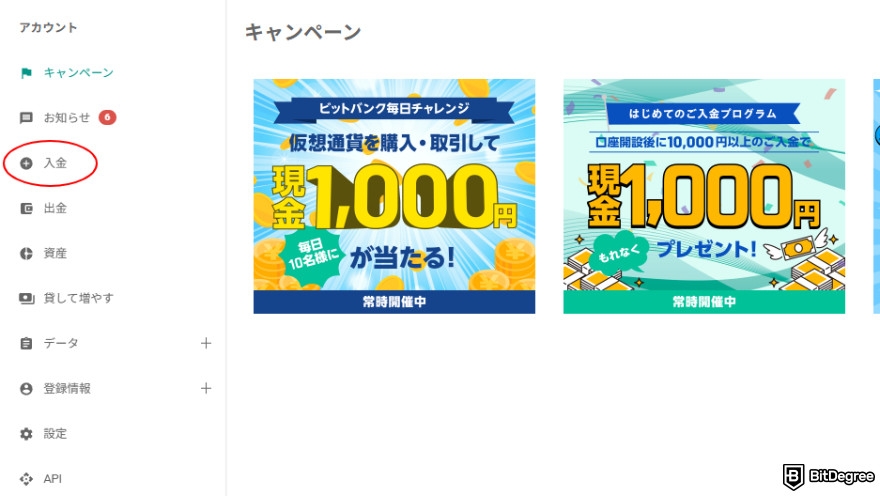
Step 2: Select Bitcoin. On the deposit page, locate BTC and click [入金] (Deposit) to proceed.
Step 3: Copy Your Address. Your BTC deposit address and QR code will be displayed. You can copy the address by clicking the [Clip Icon], or if you prefer, scan the QR code to enter the address automatically.
Step 4: Finalize. Enter the Bitbank BTC deposit address into the withdrawal section of the exchange or wallet you’re sending funds from, then complete the transaction.
Once your deposit is processed and confirmed on the blockchain, your Bitbank balance will be updated.
Latest Binance Coupon Found:Sign up on Binance and claim up to $600 worth of rewards for completing simple tasks. Use Binance referral code (49316610) to activate the offer while it's still valid!
How to Withdraw From Bitbank
Let’s say you’ve locked in some gains on Bitbank, and now it’s time to cash out! Whether securing profits or simply transferring funds, here’s a step-by-step guide to withdrawing JPY to your bank account:
Step 1: Access the Withdrawal Section. On the Bitbank homepage, click the [出金] (Withdraw) button to begin the process.
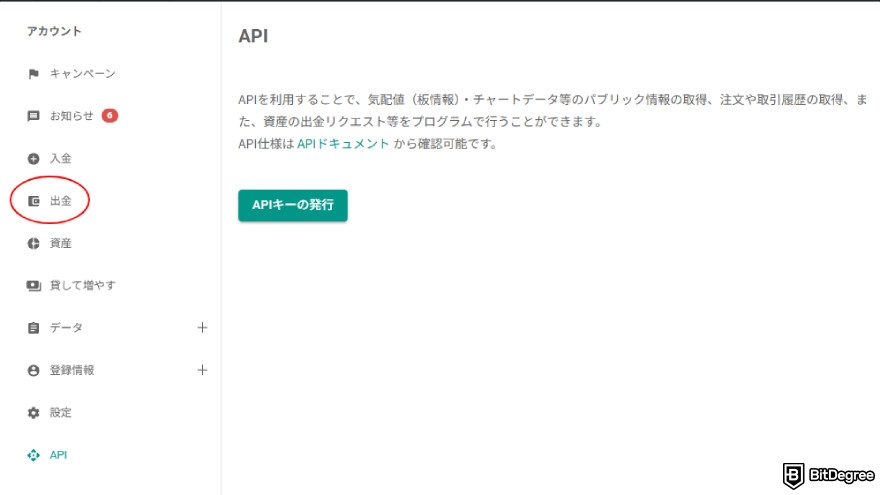
Step 2: Select JPY. From the list of available withdrawal options, find JPY and click [出金] (Withdraw).
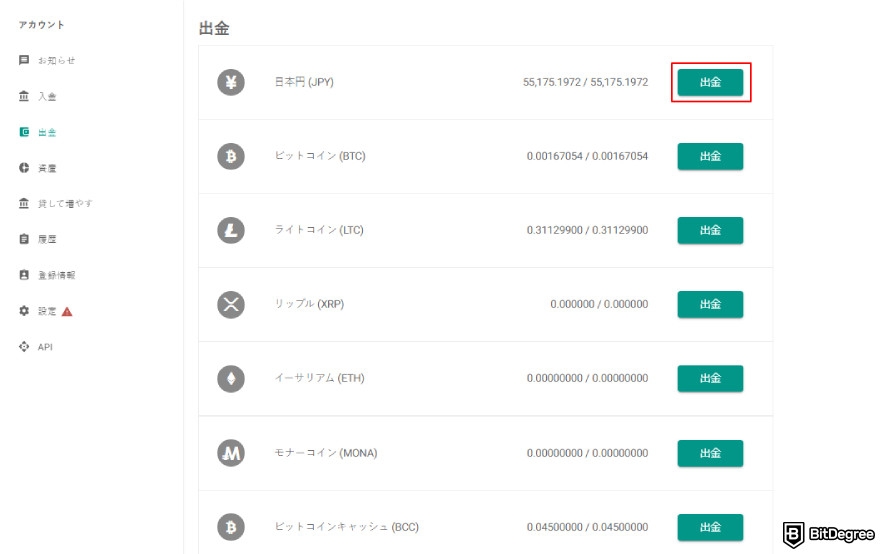
Step 3: Register Your Bank Account. If you haven’t added a bank account yet, click [銀行口座を登録] (Register Bank Account) and complete the required details.
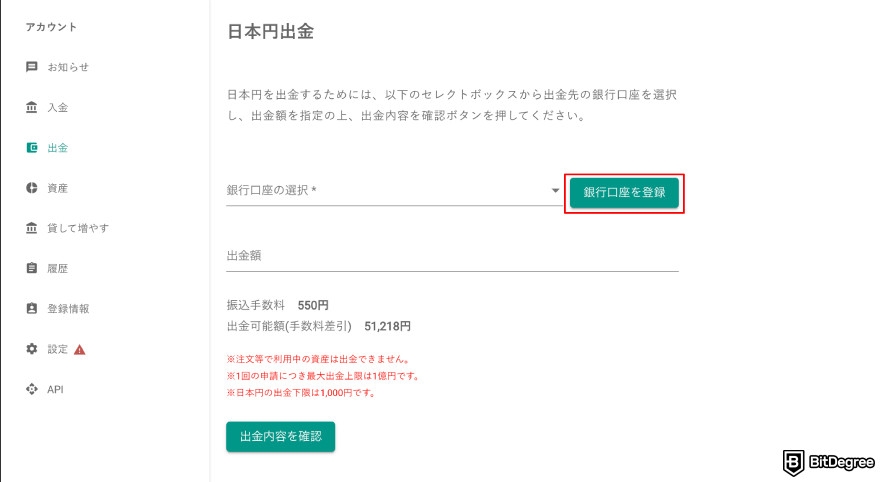
Step 4: Enter Withdrawal Amount. Select your registered bank account, input the amount you wish to withdraw, and click [出金内容を確認] (Confirm Withdrawal Details).
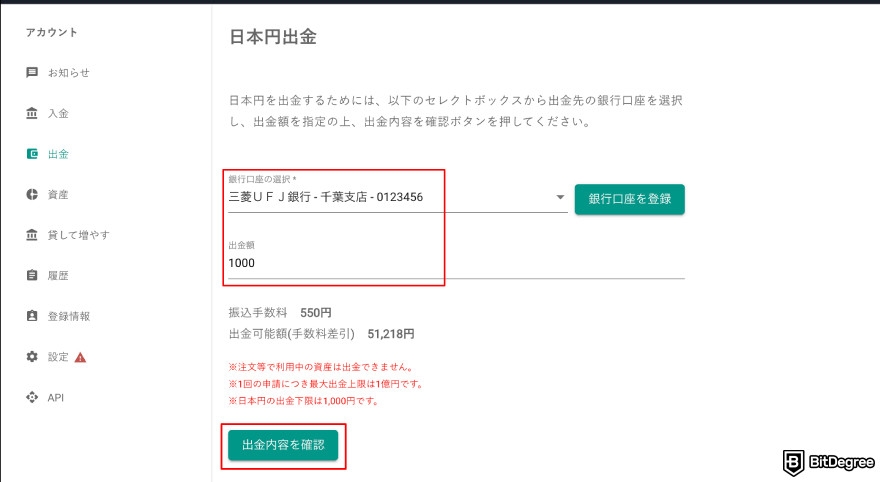
Step 5: Confirm the Withdrawal. Review your withdrawal details, and if you have SMS verification or 2FA enabled, enter the verification code and click [出金する] (Withdraw) to proceed.
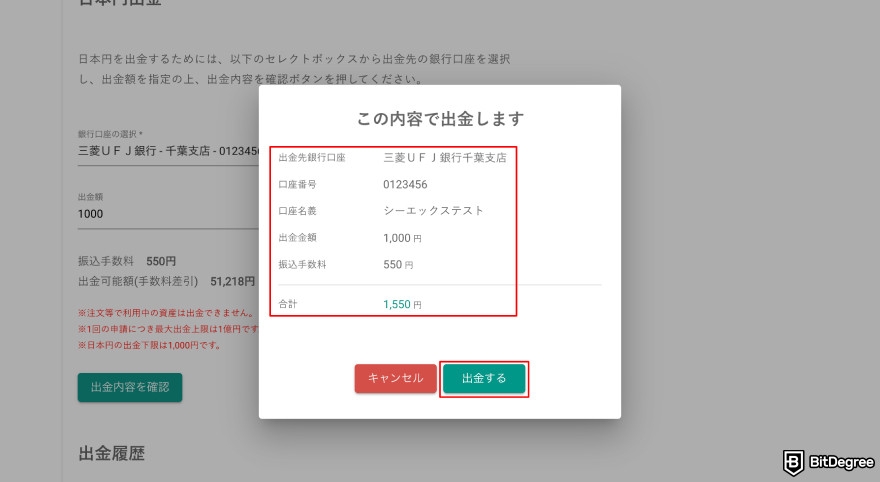
Once your withdrawal request is successfully submitted, you’ll receive a confirmation email. After Bitbank processes your withdrawal, you’ll get another email notifying you that the funds have been sent to your bank account.
And that’s it—you’ve successfully withdrawn your hard-earned yen!
Comparison to Other Popular Exchanges
Before wrapping up this Bitbank review, let’s size up the alternatives I mentioned earlier and see how they compare. By breaking down their features, strengths, and trade-offs, you’ll have a much better sense of whether Bitbank is the right option or if one of the alternatives fits your needs better.
Bitbank VS Bybit
Bybit is one of the biggest names in crypto. Launched in 2018, it has rapidly grown into a global powerhouse, supporting over 54 million users across 160 countries—a scale that makes Bitbank’s Japan-only focus seem much smaller in comparison.
When it comes to product offerings, the gap is undeniable. Bybit lists over 1,700 assets, offering a far broader selection of cryptocurrencies. Beyond spot trading, it also provides futures, options, and leveraged trading—features that Bitbank doesn’t support at all at the time of writing.
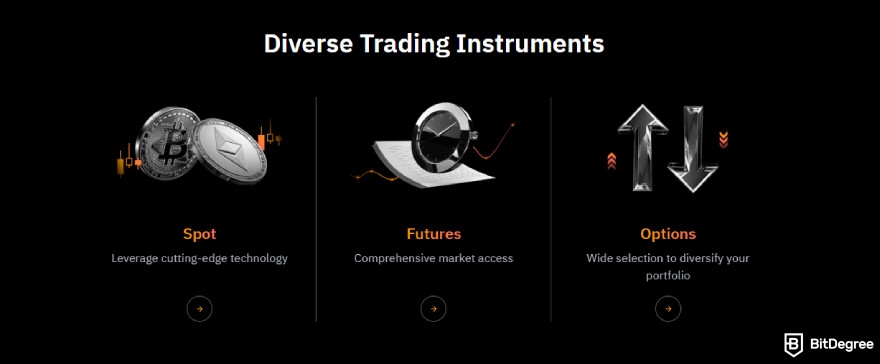
If passive income is what you’re after, Bybit Earn has you covered with a wide range of options. From staking and liquidity pools to on-chain earning products, it offers APYs that can exceed 500%, a level of flexibility that Bitbank simply can’t compete with.
For those who prefer automation, Bybit takes it a step further with customizable trading bots that support futures grid, spot grid, DCA, and futures combo strategies.
Bitbank | Bybit | |
|---|---|---|
Trading Fees | -0.02% maker / 0.12% taker | 0.10% maker / 0.10% taker (as low as 0.005% / 0.015%) |
Global Accessibility | Japan only, with limited exceptions for certain entities | Available in 160 countries |
Supported Fiat | JPY | EUR, GBP, USD, 17 more |
Cryptocurrency Availability | BTC, ETH, XRP + 40 more | BTC, ETH, XRP + 1700 more |
Interface Language | Japanese only | English, Japanese, Spanish, +13 more |
Table: Bitbank VS Bybit
And if that’s not enough, Bybit Aurora AI makes things even easier by generating and recommending 18 sets of trading bot strategies. These AI-powered tools lower the barrier to entry for algorithmic trading, allowing users to engage in complex bot strategies with nothing more than their investment amount.
📚 Read More: Bybit Review
Bitbank VS bitFlyer
When it comes to Japanese crypto exchanges, bitFlyer is one of the first names that comes to my mind. I still remember its claim of leading Japan’s Bitcoin trading volume for nine straight years, a streak that solidified its reputation as the go-to exchange for local traders.
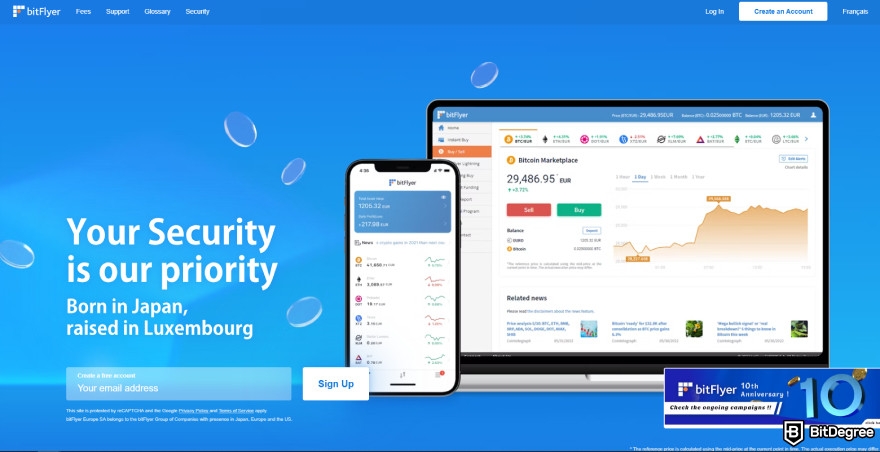
At first glance, bitFlyer and Bitbank seem pretty similar in what they offer. But after digging deeper, I have to say that bitFlyer feels more beginner-friendly. It has this easy-to-use quick trade feature, a sleek design, and an intuitive mobile app that makes buying and selling crypto feel seamless.
But here’s where the biggest difference kicks in for me—bitFlyer supports English. That alone makes it way more accessible for global users. Meanwhile, Bitbank sticks strictly to Japanese, meaning if you don’t read the language, you’ll be relying on Google Translate or just good old intuition to get around.
Bitbank | bitFlyer | |
|---|---|---|
Trading Fees | -0.02% maker / 0.12% taker | 0.10% maker / 0.10% taker (as low as 0.03%) |
Global Accessibility | Japan only, with limited exceptions for certain entities | Japan, US, Europe |
Supported Fiat | JPY | USD, EUR, JPY |
Cryptocurrency Availability | BTC, ETH, XRP + 40 more | BTC, ETH, XRP + 35 more |
Interface Language | Japanese only | Japanese, English, French |
Table: Bitbank VS bitFlyer
Beyond accessibility, bitFlyer also has a regulatory edge. It’s one of the few crypto exchanges licensed to operate across the US, EU, and Japan, giving it global compliance that Bitbank doesn’t have.
📚 Read More: bitFlyer Review
Bitbank VS Uphold
Uphold is a multi-asset digital platform where you can trade crypto, fiat, and even precious metals—all in one place.
With over 300 cryptocurrencies, Uphold gives you more trading options and flexibility. Plus, it offers early access to new tokens before they hit other platforms. Combined with its in-depth research and insights, it’s positioned as a go-to platform for discovering promising assets before they go mainstream.
Bitbank | Uphold | |
|---|---|---|
Trading Fees | 0.02% maker / 0.12% taker | 0.25% - 2.95% |
Global Accessibility | Japan only, with limited exceptions for certain entities | Available in +140 countries |
Supported Fiat | JPY | USD, GBP, EUR, + 24 more |
Cryptocurrency Availability | BTC, ETH, XRP + 40 more | BTC, ETH, XRP + 300 more |
Interface Language | Japanese only | English |
Table: Bitbank VS Uphold
If passive income is your thing, Uphold’s staking options cover 19+ cryptocurrencies, with rewards reaching up to 14.8% APY.
On the institutional side, Uphold also caters to corporate and enterprise clients, providing deep liquidity, large order execution, and seamless API integration. With over nine years of experience in the game, it’s built for high-volume traders and businesses that want a reliable, scalable trading environment.
📚 Read More: Uphold Review

- Secure and reliable
- Accepts fiat currencies
- Lots of trading options
- Reputable exchange
- Accepts fiat currencies
- Offers various trading options

- Fiat currencies - accepted
- Simple to use
- Accepts only the most trustworthy cryptocurrencies
- A leading cryptocurrency exchange platform
- Best for beginner investors
- Accepts fiat currencies

- Fully reserved and transparent
- Multiple tradable asset classes
- Over 300 supported cryptos
- Over 300 cryptocurrencies
- Secure & transparent
- Fully reserved
Conclusions: Is Bitbank Right for You?
If you’re a resident of Japan, an overseas trader living in the country, or an enterprise seeking a service tailored to the Japanese market, then yes, it's a good choice. The exchange is easy to use, secure, well-regulated, and offers competitive fees, as I’ve detailed throughout this Bitbank review.
That said, if you’re not a Japanese resident or aren’t familiar with the language (and don’t want to rely on a translator), platforms like Uphold, Bybit, or BitFlyer might be better options. They provide better accessibility and cater to a broader range of users globally.
And if those alternatives still don’t meet your expectations, don’t worry! You can check out the BitDegree Tracker to help you find the ideal platform in the vast sea of options out there.
The content published on this website is not aimed to give any kind of financial, investment, trading, or any other form of advice. BitDegree.org does not endorse or suggest you to buy, sell or hold any kind of cryptocurrency. Before making financial investment decisions, do consult your financial advisor.
Scientific References
1. Abraham M.: 'Crypto lending and stable coin de-pegging: Key risks and challenges';
2. R Fatemeh, M Yi, H Ke, et al.: 'Enhanced bitcoin with two-factor authentication'.






